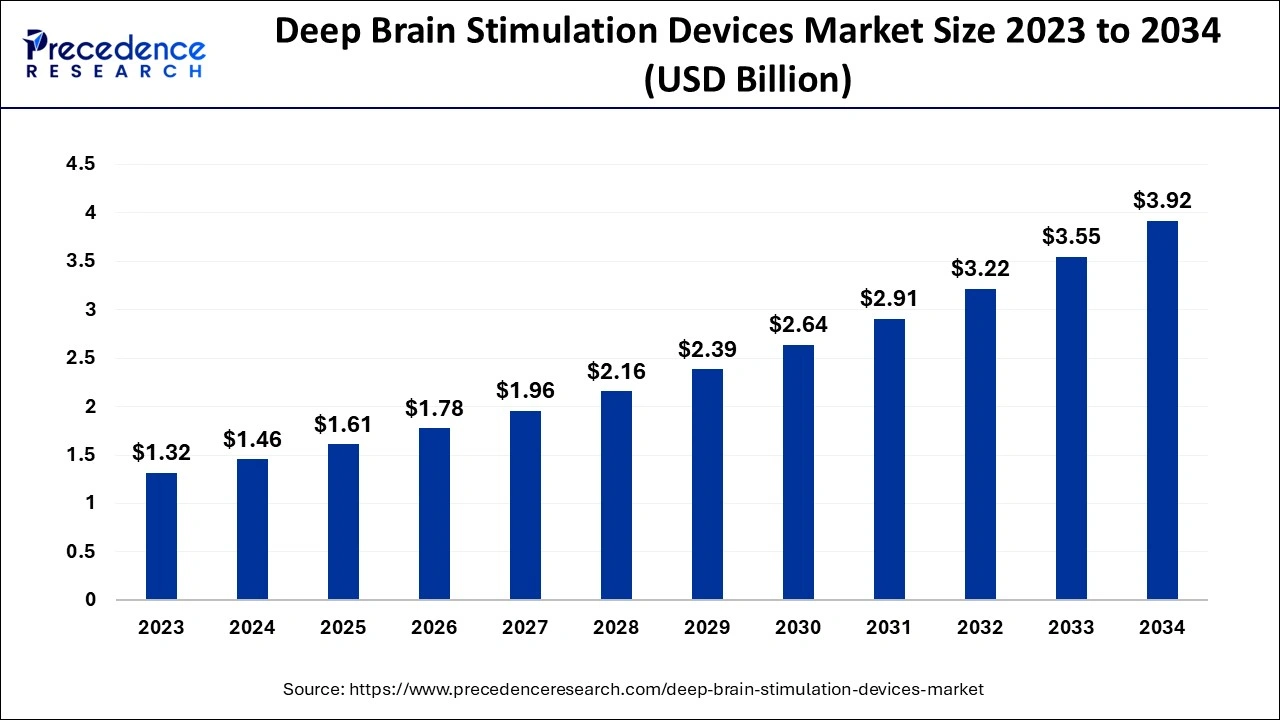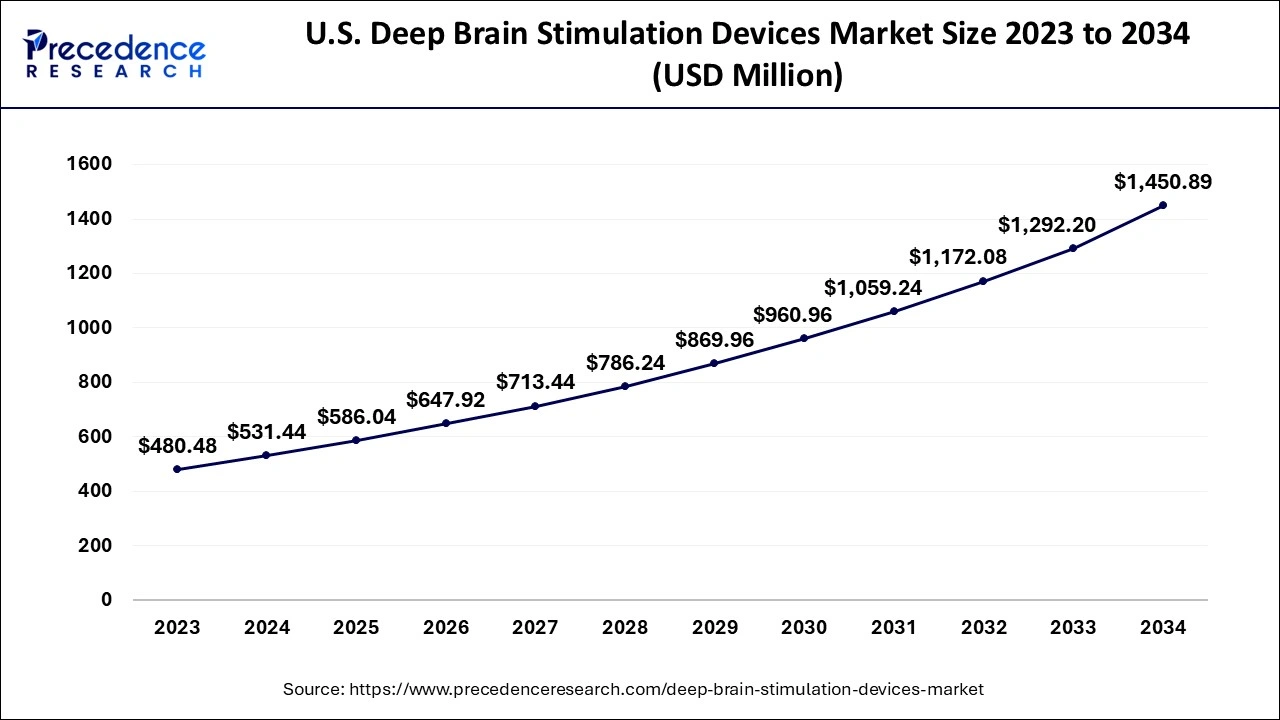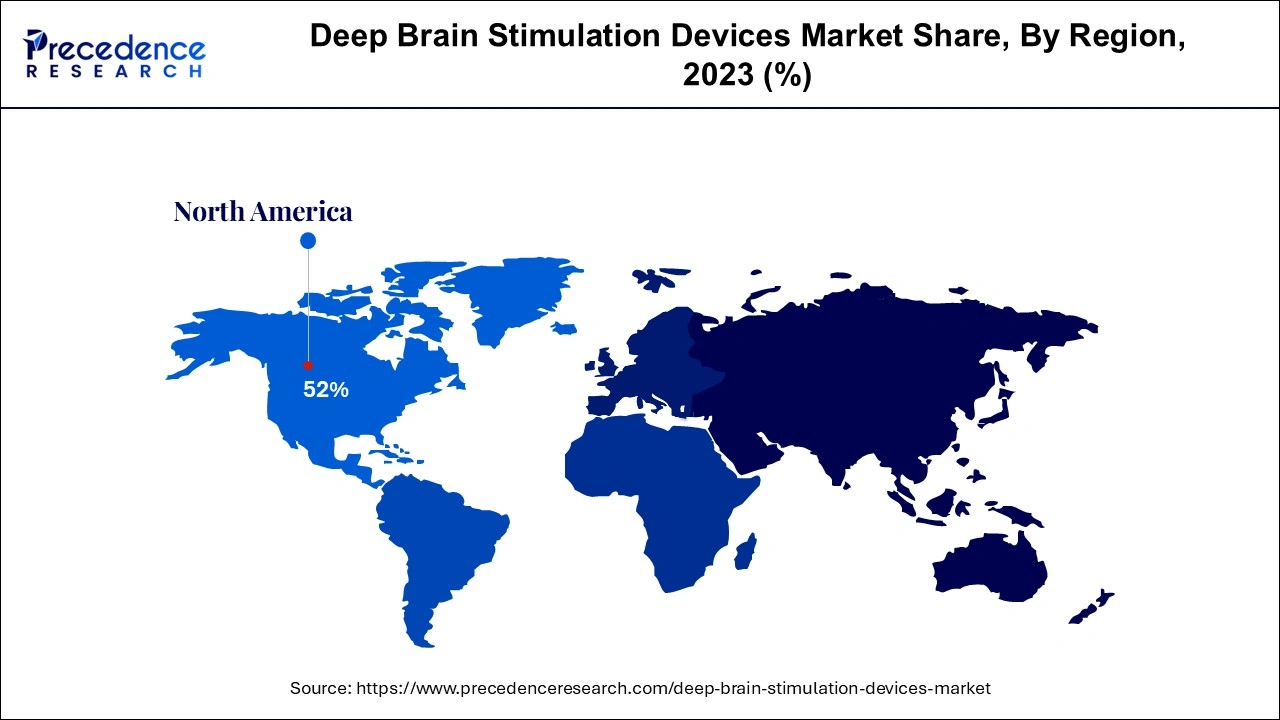October 2024
The global deep brain stimulation devices market size accounted for USD 1.46 billion in 2024, grew to USD 1.61 billion in 2025 and is predicted to surpass around USD 3.92 billion by 2034, representing a healthy CAGR of 10.40% between 2024 and 2034. The North America deep brain stimulation devices market size is calculated at USD 0.76 billion in 2024 and is expected to grow at a fastest CAGR of 10.45% during the forecast year.
The global deep brain stimulation devices market size is accounted for USD 1.46 billion in 2024 and is anticipated to reach around USD 3.92 billion by 2034, growing at a CAGR of 10.40% from 2024 to 2034.

The U.S. deep brain stimulation devices market size is evaluated at USD 531.44 million in 2024 and is predicted to be worth around USD 1450.89 million by 2034, rising at a CAGR of 10.57% from 2024 to 2034.

The deep brain stimulation device market study covers a variety of geographical areas, including North America, Europe, Asia Pacific, the Middle East, and Africa. During the projected period, it is predicted that the North American market would take the lead among these. This is due to the expanding research and development operations in the healthcare sector, which have led to an increase in innovations in that field. Major firms in the sector also have a well-established presence in the U.S., which will help the market expand. For instance, big corporations like Medtronic, Abbott, Boston Scientific, and a select few others owned the majority of the market share for deep brain stimulation devices in the United States, boosting regional growth from 2024 to 2034. Additionally, a growing patient base with neurological illnesses will encourage additional market growth in North America.

Due to the rising demand in nations like Japan, China, and India, the market value in the Asia Pacific region is anticipated to rise at the fastest rate. due to rising healthcare costs across the area as a result of rising disposable incomes. The Asia Pacific DBS market size will also be boosted by rising public awareness of a variety of neurological disorders like epilepsy, essential tremors, and Parkinson's disease. A significant growth-stimulating aspect is the expanding availability of medical facilities such as multispecialty hospitals and specialty clinics. A major factor promoting market expansion is the rising ratio of neurologists and other medical professionals employed in the Asian market.
On the contrary side, Europe is anticipated to have considerable market expansion due to the existence of various nations where chronic neurological problems are common. The high growth nations like the UK, Germany, and France will help the European market expand. In contrast to the other areas, it is projected that the deep brain stimulation device market in Latin America would expand very little. However, the industry will be driven in the future by the rising awareness in important regions like Brazil. Due to the increasing frequency and public awareness of neurological illnesses, the Middle East and Africa are predicted to continue seeing consistent growth in the coming years.
A surgical method called deep brain stimulation involves implanting a device that sends electrical signals to the parts of the brain in charge of controlling movement. A DBS system is made up of three components that are implanted within the body of a patient: a lead, an extension, and a neurostimulator. The lead links the pacemaker device to the brain to synchronize electrical pulses. DBS devises aid in lowering the stiffness and tremor symptoms brought on by a number of neurological conditions, including Parkinson's disease, dystonia, or essential tremor. People can reduce their drug dosage after deep brain stimulation surgery, perhaps removing any negative effects.
Due to the rising occurrence of neurological illnesses, the deep brain stimulation systems market is anticipated to develop profitably throughout the forecasted period. One of the key reasons driving market expansion is the rising prevalence of Parkinson's disease across a number of continents. For example, the Parkinson's Foundation estimates that over 10 million individuals worldwide suffer from Parkinson's disease. Demand for DBS devices will also increase due to the increased prevalence of essential tremors and dystonia. As a result, the aforementioned factor will considerably boost the growth of the deep brain stimulation devices market during the course of the forecast year.
Additionally, neurological problems are more common in adults over the age of 65. Therefore, the incidence of neurological illnesses would be significantly stimulated by the rising rate of the senior population, expanding the market. Another important element driving the use of DBS procedures and consequently boosting market growth is the population's increased awareness of a variety of neurological conditions.
During the ongoing coronavirus epidemic, telehealth and eHealth applications are becoming more and more popular for frequently monitoring PD patients. The global market for deep brain stimulation devices for Parkinson's disease is growing as a result of favorable reimbursement policies in healthcare institutions. However, implanted pulse generators for DBS devices require technical breakthroughs. Therefore, businesses in the Parkinson's disease market for deep brain stimulation devices should invest more in R&D to maximize battery life, along with patient-related factors like patient compliance with nightly device cut-off or IPG recharging dependability. For medical technology businesses to acquire a competitive edge in the worldwide deep brain stimulation devices market for Parkinson's disease, device-specific aspects including parameter delivery, lead configuration choice, implantation site, and cautious electrode material selection are critical.
Companies that make deep brain stimulation devices for Parkinson's disease are working harder to sell their products internationally. Other businesses involved in the DBS (deep brain stimulation) sector have products, but they are still in the clinical development stage and are not yet commercially accessible. Businesses are eager to release novel goods that are simple for patients and doctors to use. These businesses seek to increase the gadgets' portability, affordability, efficiency, and effectiveness.
| Report Coverage | Details |
| Market Size in 2024 | USD 1.46 Billion |
| Market Size by 2034 | USD 3.92 Billion |
| Growth Rate from 2024 to 2034 | CAGR of 10.40% |
| Largest Market | North America |
| Fastest Growing Market | Asia Pacific |
| Base Year | 2023 |
| Forecast Period | 2024 to 2034 |
| Segments Covered |
|
| Regions Covered |
|
The rising desire for less invasive operations among the general public
Growth in the market will be affected by the unprecedented growth in the geriatric population
The increasing geriatric population is propelling the market growth
The market is divided into single-channel and dual-channel deep brain stimulation devices depending on the product. With a market share of 58.2% in 2023, the dual-channel sector is in the lead due to its greater use in surgical operations. One of the safest and most efficient tools used in surgical operations is dual channels. As a result, the increased frequency of debilitating neurological disorders, the rise in PD surgery, and the number of hospitals utilizing dual-channel DBS devices are all contributing to the segment's growth. Additionally, new product introductions and technology developments are fueling category growth. For instance, the U.S. FDA granted clearance for the additional indication of Parkinson's disease to Abbott's Infinity DBS system in January 2020. This method will enable the targeting of the internal Globus Pallidus (GPi), a particular region of the brain linked to the symptoms of Parkinson's disease.
From 2024 to 2034, the single-channel deep brain stimulation device market is anticipated to expand at the greatest compound annual growth rate (CAGR), or 10.6%. Healthcare experts feel that single-channel DBS devices are more popular because neurologists like them since they provide more programming choices. The Parkinson's Foundation claims that older people are more likely to have neurological disorders. For instance, the World Ageing 2019 study estimates that there were around 703 million individuals worldwide who were 65 or older in 2019. Thus, it is projected that the segment would rise as a result of the ageing population, patients' rising knowledge of neurological illnesses, and healthcare professionals' choice.
The market is divided into segments for pain management, essential tremor, epilepsy, depression, obsessive-compulsive disorders (OCD), Parkinson's disease, dystonia, and others based on the applications they are used for. Due to the rising number of deep brain stimulation therapies that have been approved by the U.S. FDA and the high incidence of Parkinson's disease (PD) in the world, the Parkinson's disease segment is expected to dominate the market in 2021 with a share of 65.4%. The Verses deep brain stimulation device system for the treatment of Parkinson's disease was approved by the U.S. FDA in December 2017 for use by Boston Scientific Corporation. The Parkinson's Foundation estimates that 60,000 Americans are given PD diagnoses each year. In the upcoming years, this is predicted to fuel the segment's expansion.
From 2024 to 2034, the epilepsy category is anticipated to experience the greatest compound annual growth rate (CAGR), at 16.4%. In the upcoming years, it is anticipated that rising consumer knowledge of cutting-edge epilepsy treatment alternatives will combine with expanding healthcare infrastructure to further accelerate category expansion. The World Health Organization (WHO) estimates that 50 million individuals worldwide have epilepsy, making it one of the most prevalent neurological conditions. Due to the poor therapeutic response of medications in treating seizures and the low success rates of procedures, DBS is utilized in epilepsy. This will fuel sector growth even further.
With a share of 52.8% in the end-use sector in 2024, hospitals led the total market growth. The rise in Parkinson's disease and essential tremor prevalence as well as the rise in DBS procedures conducted in hospitals are the key causes of this market segment's expansion. During the projected period, it is also anticipated that the availability of technologically improved DBS devices along with attractive reimbursement policies would further propel the hospital market. For an instance, Medtronic provides thorough services to establish and maintain coverage as well as payment for a range of DBS devices.
In addition, hospitals are currently improving technologically, and sophisticated gadgets are widely utilized in hospitals to deliver better care. These tools assist produce better, quicker, and more accurate outcomes in addition to streamlining treatment methods. Most neurological problems, including Parkinson's disease, are identified and managed by qualified neurologists who work in specialized facilities and utilize cutting-edge technology.
From 2024 to 2034, the Ambulatory Surgical Centers (ASC) category is anticipated to see the greatest compound annual growth rate (CAGR), at 10.3%. This is because the procedures are less expensive than in hospitals, and patients have easier access to care and wait less time than in hospitals and neurology clinics. Additionally, research by Advancing Surgical Care found that 92% of patients were happy with the medical attention and service they received at ASCs, which helped the segment thrive. Additionally, because the surgical techniques used at ASCs are sophisticated and less invasive, the majority of neurosurgeries may now be completed there.
By Product
By Application
By End-Use
By Geography
For inquiries regarding discounts, bulk purchases, or customization requests, please contact us at sales@precedenceresearch.com
No cookie-cutter, only authentic analysis – take the 1st step to become a Precedence Research client
October 2024
November 2024
March 2025
October 2024